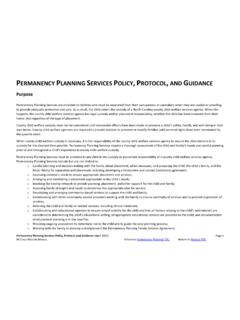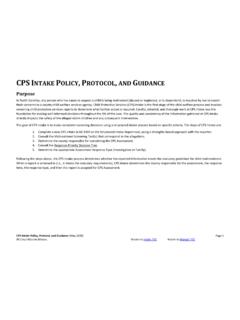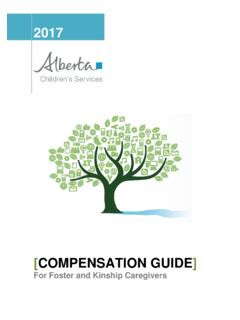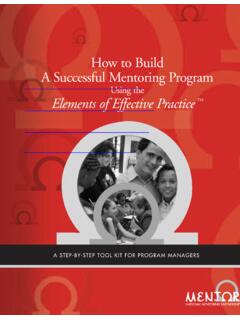Transcription of PERMANENCY POLICY PROTOCOL AND GUIDANCE - Policies …
1 PERMANENCY PLANNING POLICY , PROTOCOL , AND GUIDANCE . Purpose PERMANENCY Planning Services are provided to children who must be separated from their own parents or caretakers when they are unable or unwilling to provide adequate protection and care. As a result, the child enters the custody of a North Carolina county child welfare services agency. When this happens, the county child welfare services agency has legal custody and/or placement responsibility, whether the child has been removed from their home, and regardless of the type of placement. County child welfare custody must not be considered until reasonable efforts have been made to preserve a child's safety, health, and well-being in their own home. County child welfare agencies are required to provide services to preserve or reunify families until parental rights have been terminated by the juvenile court. When county child welfare custody is necessary, it is the responsibility of the county child welfare services agency to ensure the child remains in its custody for the shortest time possible.
2 PERMANENCY Planning Services require a thorough assessment of the child and family's needs and careful planning prior to and throughout a child's experience in county child welfare custody. PERMANENCY Planning Services must be provided to any child in the custody or placement responsibility of a county child welfare services agency. PERMANENCY Planning Services include but are not limited to: o Careful planning and decision making with the family about placement, when necessary, and preparing the child, the child's family, and the foster family for separation and placement, including developing a family time and contact (visitation) agreement;. o Assessing children's needs to ensure appropriate placement and services;. o Arranging and monitoring a placement appropriate to the child's needs;. o Involving the kinship network to provide planning, placement, and other support for the child and family;. o Assessing family strengths and needs to determine the appropriate plan for service.
3 O Developing and arranging community-based services to support the child and family;. o Collaborating with other community service providers working with the family to ensure continuity of services and to prevent duplication of services;. o Referring the child and family to needed services, including clinical treatment;. o Collaborating with educational agencies to ensure school stability for the child and that all factors relating to the child's best interest are considered in determining the child's educational setting; all appropriate educational services are provided to the child; and documentation of educational planning is in the case file;. o Providing ongoing assessment to determine risk to the child and to guide the case planning process;. o Working with the family to develop and implement the Out-of-Home Family Services Agreement (OH-FSA);. PERMANENCY Planning Services POLICY , PROTOCOL , and GUIDANCE (July 2019) Page 1.
4 NC CHILD WELFARE MANUAL Return to PERMANENCY Planning TOC Return to Manual TOC. o Helping the family meet the OH-FSA objectives by providing information, instruction, GUIDANCE , and mentoring related to parenting skills, and by monitoring and updating the agreement with the family;. o Providing case planning and management;. o Concurrent PERMANENCY planning with the family to develop alternative options to provide a permanent home for a child should reunification fail;. o Supervising the placement to ensure the child receives proper care during placement;. o Preparing for and participating in court proceedings;. o Preparing for and facilitating Child and Family Team / PERMANENCY Planning Review meetings;. o Providing transportation for children in county child welfare agency custody when needed and not otherwise available, including visits with parents, siblings, and relatives;. o Providing LINKS services to assist older youth in learning life skills necessary to make a successful transition from foster care to living on their own.
5 O Ensuring placements across state lines comply with the Interstate Compact on the Placement of Children (ICPC);. o Recruiting and assessing relatives and other kin as potential caregivers ;. o Involving foster parents in planning and decision making for children in county child welfare agency custody;. o Preparing children for adoptive placements and maintaining life books; and o Maintaining the PERMANENCY planning case record and thorough documentation of case activities. Foster care can be defined as a situation in which, for a period, a child lives with and is cared for by people who are not the child's parents. There are different forms of foster care, including but not limited to: o Family foster homes, o Therapeutic foster homes, and o Residential care. For child welfare, foster care refers to children in the legal custody of a county child welfare services agency; however, a child may also be placed in foster care by their parent without involvement of a county child welfare services agency.
6 PERMANENCY Planning Services POLICY , PROTOCOL , and GUIDANCE (July 2019) Page 2. NC CHILD WELFARE MANUAL Return to PERMANENCY Planning TOC Return to Manual TOC. PERMANENCY PLANNING SERVICES. Table of Contents Description Page POLICY & Legal Basis 6. Required Timeframes (for compliance with POLICY and PROTOCOL ) 9. PROTOCOL and GUIDANCE Case Staffing / Two-Level Decision Making / Role of Supervisor 13. Required Forms 15. Planning Forms 15. Relative Notification 15. PERMANENCY Planning Review / Out of Home Family Services Agreement 17. Family Time and Contact (Visitation) Plan 21. Decision-Making Tools 23. Child Health Summary Components 25. Child Education Status Form and Best Interest Determination Form 28. Monthly PERMANENCY Planning Contact Record 29. Eligibility/Payment/Reporting Forms 30. Child Placement and Payment System Report 30. SIS Client Entry Form 30. Determination of Foster Care Assistance Benefits and/or Medical Assistance Only and Redetermination 31.
7 Of Foster Care Assistance Benefits and/or Medical Assistance Only Domestic Violence and PERMANENCY Planning 32. Human Trafficking 33. Placement Decision Making: Maintaining One Single, Stable Placement 34. Choosing the Best Placement Resource 34. Placement with Siblings 35. Placement Options 36. kinship Care (Relative and Non-Relative Kin) 37. kinship Care Assessment: Licensure and Approval 38. Other Placement Resources 39. PERMANENCY Planning Services POLICY , PROTOCOL , and GUIDANCE (July 2019) Page 3. NC CHILD WELFARE MANUAL Return to PERMANENCY Planning TOC Return to Manual TOC. PERMANENCY PLANNING SERVICES. Table of Contents Description Page Special Legal Considerations in Placement Decision Making 41. Multiethnic Placement Act of 1994 and Amendment (MEPA-IEP) 41. Indian Child Welfare Act of 1978 41. Mexican Heritage 41. Preparing Parents, Children, and Providers for Placement 42. Preparing Parents and Children 42.
8 Preparing Placement Providers 42. Reasonable and Prudent Parent Standard 42. Out-of-Home Placement Services 44. Required Contacts 44. Initial Contacts 44. Ongoing Contacts 46. Water Safety Hazards 50. Ongoing Placement Services 52. Required Services for Children 52. Authorization for Healthcare Services 53. Ongoing Needs Assessment 54. Life Books 54. Required Services for Parents 57. Required Services for Placement Providers 59. Ongoing Risk Assessment 60. Educational Stability 61. School Attendance 61. Every Student Succeeds Act 61. Parent/Child Visitation/Family Time 67. Sibling Visitation 71. Agency Plan for Abducted and Runaway Children 72. PERMANENCY Planning Services POLICY , PROTOCOL , and GUIDANCE (July 2019) Page 4. NC CHILD WELFARE MANUAL Return to PERMANENCY Planning TOC Return to Manual TOC. PERMANENCY PLANNING SERVICES. Table of Contents Description Page Shared Parenting 81. PERMANENCY Planning 86.
9 PERMANENCY Options 86. Reunification 88. Guardianship 90. Custody 95. APPLA 96. Adoption 97. Reinstatement of Parental Rights 101. Concurrent Planning 103. PERMANENCY Planning Hearing 105. Child and Family Team / PERMANENCY Planning Review Meetings 107. PERMANENCY Planning Review Team Meetings 107. Child and Family Team Meetings 112. Termination of Services 113. Preparing the Child 113. Preparing the Family for Reunification 114. Preparing the Foster Family 114. Preparing the Adoptive Family or Other Permanent Caregiver 115. Aftercare Services 115. Documentation and Record Keeping 116. Adolescent Services: NC LINKS 121. Transportation Really Is Possible Program Criteria 166. Foster Care 18 to 21 174. PERMANENCY Planning Services POLICY , PROTOCOL , and GUIDANCE (July 2019) Page 5. NC CHILD WELFARE MANUAL Return to PERMANENCY Planning TOC Return to Manual TOC. PERMANENCY PLANNING SERVICES. POLICY and Legal Basis POLICY Legal Basis PERMANENCY Planning Services must be provided Foster care services are provided in compliance with the statutory requirements of federal and to any child in the custody or placement state laws.
10 Federal and state law is intended to provide protections for children in foster care, who responsibility of a county child welfare services need safety and PERMANENCY , and for their families to ensure that their legal rights are maintained. agency. 108A-14 states the County Director of Social Services has the responsibility and the duty Reunification with the parents or caretakers to investigate reports of child abuse, neglect, and dependency; to take appropriate action to from whom the child is removed must be the protect such children and to accept children for placement in foster homes and to supervise primary plan unless the juvenile court placements for as long as such children require foster care. determines it is inconsistent with the child's needs for safety. 108A-48 states the Department of Health and Human Services is authorized to establish a State Foster Care Benefits Program with appropriations by the General Assembly for the purpose When removal is necessary to preserve a child's of providing assistance to children who are placed in foster care facilities by county departments of safety and well-being, the county child welfare social services in accordance with the rules and regulations of the Social Services Commission.












